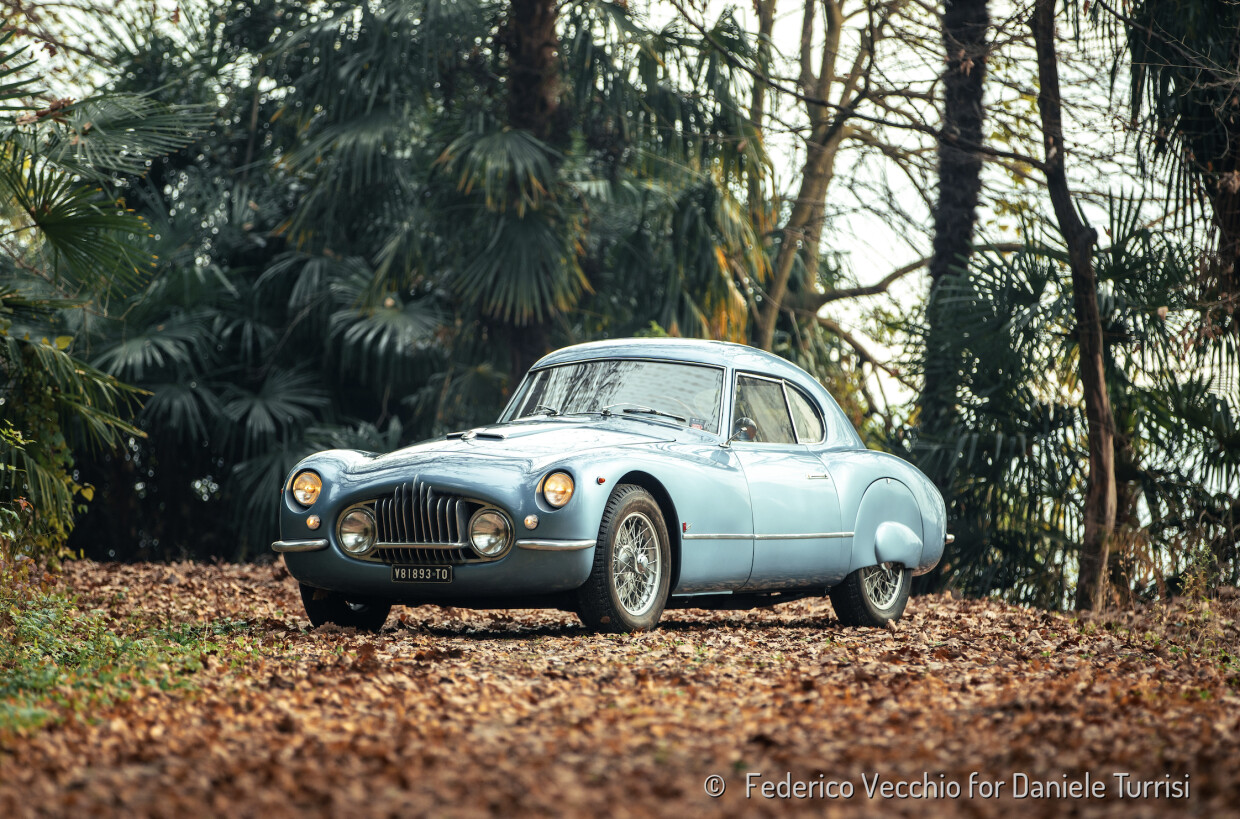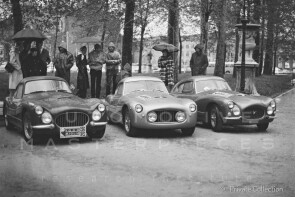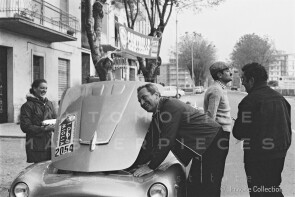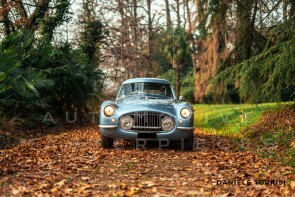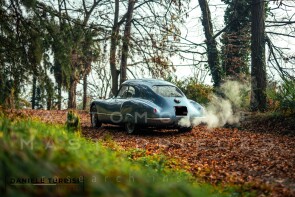
1954 Fiat 8V
ON/OFF
Why am I an Automotive Masterpiece?
L. Limited edition cars
no. 30 manufactured, 28th built. Third-to-last of all 8V chassis no. The only II series with a I series body shape.
In the postwar period, Fiat was working on an eight-cylinder engine internally known as Tipo 106. The engine was originally designed by Dante Giacosa for a luxury sedan, but that project was stopped. Rudolf Hruska, at the time working at the S.I.A.T.A., was given the task to design a car around the V8 engine. The development took place in absolute secrecy. As not to stress the experimental department of Fiat, production of the chassis was also taken up by S.I.A.T.A. Styled by chief designer Fabio Luigi Rapi, the Fiat 8V or “Otto Vù” was presented to the Italian press in February 1952 and first exhibited the following March at the Geneva Motor Show. The car shapes saw several changes in time: the prototype used an art deco grill that extended into the hood. A second series was made featuring four headlights with some of the later cars having a full-width windscreen. A high-performance coupé, destined to compete in the GT class: the 2-liter 8V model was a departure from the usual Fiat production. It was really welcomed by Italian private drivers, it inspired the tuners, and it was, in a word, the car to beat in the 2-liter class, also thanks to the special versions built by Zagato or Siata. The Fiat V8 had a 70° V configuration of 1996 cc of displacement, at 5600 rpm the engine produced 105 hp (78 kW) in standard form with double two-barrel Weber 36 DCS carburetors, giving a top speed of 190 km/h (118 mph). Some engines were fitted with huge four-throat Weber 36 IF4/C carburetors offering 120 bhp, but the intake manifold was very rare. The Fiat 8V is the only eight-cylinder built by Fiat. The engine was connected to a four-speed gearbox. The car had independent suspension all round reworking the Fiat 1100 ones and drum brakes on four wheels. As the body was welded to the chassis it was a semi-unitary construction. Only 114 of these high-performance coupés had been produced, 63 with a “Fiat Carrozzerie Speciali” body, 34 first series and 29 second series. It was made available anyway in different body styles, offered by the factory and by various coachbuilders like Zagato, Pinin Farina, Ghia and Vignale. The production ceased in 1954.
The Fiat 8V, chassis no. 106*000112*, spent its entire life in Italy, as confirmed by its historical record. It was completed at the factory with a first-series body by Carrozzerie Speciali Fiat, designed by Fabio Luigi Rapi, on August 30, 1954 (certificate of origin dated September 19, 1954), but its first Torino registration (TO 208719) came much later, on June 26, 1956— a gap not uncommon among 8V cars. Interestingly, despite being the third-to-last 8V chassis produced and therefore “officially” part of the second series, chassis no. 0112 features a first-series body design, typically used only on the first 34 examples built by April 1953. Of those, 26 retained the original shapes designed by Luigi Fabio Rapi and were not re-bodied or modified. Chassis no. 106*000112*, however, stands apart and tells its own story. The pairing of a high chassis number with a first-series body puzzled even 8V expert Tony Adriaensens, who remarked: “This is a strange car as it has a first-series nose. It is possible that it is a series I which was numbered (or re-numbered) late in the series.” The car was purchased in June 1956 by trader Mauro Gardesani, but due to financial troubles leading to his bankruptcy, he sold it after just a few months. In October 1957, the car was acquired by Alessandro Ormezzano, owner of the Fratelli Ormezzano wool mill, and re-registered in Vercelli. Ormezzano sold it in February 1959 to racing driver Vittorio Casalegno. Over the years, the car changed hands several times, always retaining Italian registration. Finally, in April 1967, it was purchased by Angelo Tito Anselmi, a renowned automotive historian. Anselmi confirmed that the car was very well preserved at the time of purchase, with its original bronze metallic paint. However, not liking the color, he repainted it in metallic blue. Anselmi admitted to taking a somewhat casual approach to the car at the time, influenced by the context of the early 1970s when historical authenticity was not yet a priority, and only pre-war cars were considered true classics. Fiat's Historical Center could not confirm the legitimacy of the original bronze paint, and since the interior featured dark blue Vipla upholstery (originally, it should have been red), Anselmi decided to paint the body in a light metallic blue, recalling a color option available at the time. The original upholstery and door panels were preserved, while the heavily worn anthracite carpets were replaced with dark blue wool carpeting. Anselmi also failed to recognize that the first-series front end was an anomaly for the high chassis number. With chassis no. 106*000112*, Anselmi participated in the 1972 III Historic Mille Miglia Revival - Padova/Brescia/Rome/Padova, organized by Giulio Dubbini. He sold the car in 1973 and, while in the Pivato collection, it was featured in the Milleruote encyclopedia. In 1981, the car received its latest and current license plate, once again from Torino (TO V81893), and passed through the hands of various collectors, including notable figures like Norberto Ferretti, the "yacht king." Starting in 2001, the car began participating in Mille Miglia revivals, alternating between historic car races and prestigious concours d’elegance events, such as Villa d’Este. In 2007, the car was purchased by collector Ermanno Keller, who undertook a major restoration. It was repainted in the same color chosen by Anselmi more than 30 years prior. The blue Vipla upholstery (seats and panels) was preserved, while the blue carpet installed by Anselmi was replaced with beige carpeting featuring blue Vipla edging, as originally fitted. The matching-numbers engine was overhauled in 2008. The car received a FIVA pass. In 2024, the Fiat 8V was exhibited at Rétromobile in Paris and sold to a private collection. Currently, for practical reasons related to its use in competitions, the car is fitted with a non-original grille, though the original grille is still with the car.
